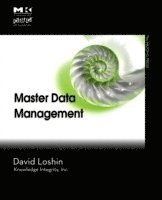
- Format
- Häftad (Paperback / softback)
- Språk
- Engelska
- Serie
- MK OMG Press
- Antal sidor
- 304
- Utgivningsdatum
- 2008-10-24
- Förlag
- Elsevier Science & Technology
- Dimensioner
- 206 x 190 x 20 mm
- Vikt
- Antal komponenter
- 1
- ISBN
- 9780123742254
- 640 g
Master Data Management
Just nu 10% rabatt på allt! Använd kod JUNI25
Handla för minst 299 kr, t.o.m. 11 juni. Villkor
- Skickas från oss inom 7-10 vardagar.
- Fri frakt över 249 kr för privatkunder i Sverige.
Passar bra ihop
De som köpt den här boken har ofta också köpt Peak Human av Johan Norberg (häftad).
Köp båda 2 för 757 krKundrecensioner
Fler böcker av författarna
-
Practitioner's Guide to Data Quality Improvement
David Loshin, David Loshin
-
Business Intelligence
David Loshin, David Loshin, David Loshin
-
Using Information to Develop a Culture of Customer Centricity
David Loshin, Abie Reifer, David Loshin, Abie Reifer
-
Big Data Analytics
David Loshin, David Loshin
Recensioner i media
"David gives sound, practical advice for business leaders and managers planning a real implementation. His material covers the key business, operational and technical elements of an enterprise reference data and master data program. He delivers a clear description of the functional and technical solutions that are available to business managers. David provides insights that can help business and technology managers to improve strategic planning, manage organizational change and simplify the operational integration of systems and business processes." --Justin S. Magruder, Vice President, Enterprise Information Strategy & Management, Freddie Mac
"Few people can serve as both an academic and a practitioner. David Loshin is one of those people and he is superbly qualified to bring sense to the topic of master data management. He has brought all his skills and experience together in this book. Anyone that is embarking on a master data management initiative will find this book a great resource, from the initial efforts to understanding the business value of master data to the methodical approach to implementation." --Tony Fisher, President, DataFlux
“With his new book on MDM, David Loshin has created a comprehensive overview of a complex topic that should be one of the top 5 priorities for CIOs: to transform an enterprise through superior management of its critical business data. Much like the SOA market, MDM needs a separate category of best practices to address the hard business problems that can only be solved through better data governance. This book does a wonderful job of posing these challenges and positing some solutions. A must-have guide for those looking to understand the IT and business issues around master data management." --Anurag Wadehra, Senior VP, Marketing & Product Management, Siperian
"Similar to David’s other books on data management; Master Data Management shares a deep understanding of how critical business issues are addressed through the managed integration of emerging technologies. This book provides a full-scale exposition on the benefits and the challenges of master data integration; describes approaches to justify, initiate and design a master data management (MDM) program; and guides the reader in a process to evaluate the numerous methods and solutions to determine the approach that best addresses the organization’s needs. This book delivers the content in the easily read, pragmatic style that has made David Loshin one of the most popular experts for both our business and technology visitors at BeyeNETWORK.com (Business Intelligence Network)." --Ron Powell, Editorial Director, Business Intelligence Network, www.B-eye-NETWORK.com
“Master data management is a new field of endeavor with deep roots in data quality management. As such, there is no better person than David Loshin to help data practitioners not only understand the intricacies of MDM...
Övrig information
David Loshin is President of Knowledge Integrity, Inc., a company specializing in data management consulting. The author of numerous books on performance computing and data management, including "Master Data Management" (2008) and "Business Intelligence - The Savvy Manager's Guide" (2003), and creator of courses and tutorials on all facets of data management best practices, David is often looked to for thought leadership in the information management industry.
Innehållsförteckning
Chapter 1) Introduction: Master Data and Master Data ManagementChapter 2) Business Process Models, Stakeholders, and Participant CoordinationChapter 3) MDM Maturity and the Implementation RoadmapChapter 4) Enterprise Data GovernanceChapter 5) The Value of Data QualityChapter 6) Data Standards and Metadata ManagementChapter 7) Identifying Master Data Chapter 8) Data Modeling Issues for MDMChapter 9) MDM Paradigms and ArchitecturesChapter 10) Data Consolidation and IntegrationChapter 11) Master Data Synchronization - Chapter 12) The Functional Application Services LayerChapter 13) Management Guidelines and Summary
Du kanske gillar
-
Peak Human
Johan Norberg
Inbunden -
Atomic Habits
James Clear
Trade paperback (UK) -
Careless People
Sarah Wynn-Williams
Inbunden


